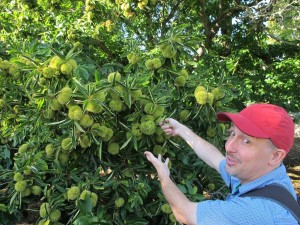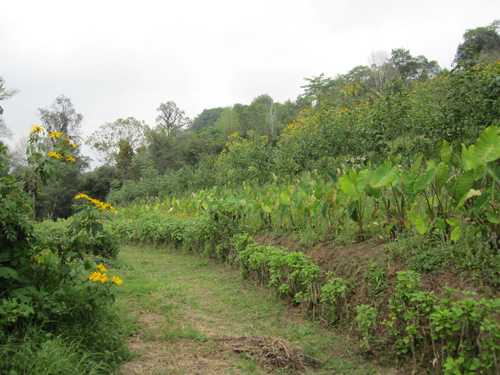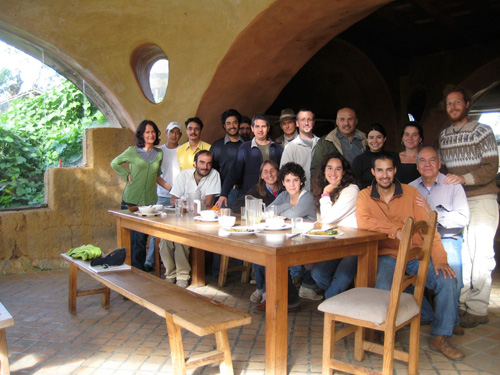Nitrogen fixation is an important ecological phenomenon and a critical element of agroecological systems. Nitrogen fixing plants, through a symbiosis with various microorganisms, can convert atmospheric nitrogen to essential nitrogen fertilizer. A great diversity of species from many widely-separated orders fix nitrogen. This is an interesting lens through which to view higher-order taxonomy, and see why it is of interest.
Wild tamarind (Lysiloma latisiliquum), a nitrogen-fixing legume native from Florida through Central America.
There are several living great divisions of plants, representing ancient lineages. The enormous division of the flowering plants is only one of these. Here are some of the major groups and their relation to nitrogen fixation.
- The Marchiantophyta, liverworts. At least some liverworts fix nitrogen, with blue-green algae as a partner.
- The Anthoceratophyta, or hornworts. Many, perhaps all, fix nitrogen with blue-green aglae.
- The Bryophytes, mosses.
- The Lycopiodopsida, clubmosses.
- The Pteridophytes, horsetails and ferns. At least one fern, the aquatic genus Azolla, fixes nitrogen, with blue-green algae as its partner.
- The Spermatopsida, seed-bearing plants, containing the great majority of plant species.
The Spermatopsida are broken further into:
- The Cycads, ancient plants that resemble palms though unrelated. All or most fix nitrogen through partnership with blue-green aglae.
- The Gingko, sole remaining species of its entire division.
- The Conifers, featuring pines, firs, and others.
- The Gnetales or jointfirs, a small group of interesting species
- The Angiosperms or flowering plants.
The Angiosperms are broken down further into many subdivisions, which are split into orders. Here’s what’s interesting: up to this point, all nitrogen fixation is through blue-green algae, we have not seen any Frankia or Rhizobia yet.
Gunnera fixes nitrogen with blue-green algae, and lives in a category of its own, distant from other flowering plants. Apparently some tropical trees have blue-green algae on their leaf surfaces serving as nitrogen fixing partners.
Now we arrive at the more familiar nitrogen fixing families, which have members that form nodules on their roots and partner with Rhizobia bacteria or Frankia actinomycetes (yeast-like bacteria). We know the legume family (Fabaceae) are the only group to partner with Rhizobia. Many seemingly diverse families contain at least some species that partner with Frankia, as a group these species are known as the actinorhizal nitrogen fixers. These families include:
- Betulaceae, the birch family.
- Myricaceae, the bayberry family.
- Casuarinaceae, the Austraian “pines”.
- Elaeagnaceae, the oleasters.
- Rosaceae, the rose family.
- Rhamnaceae, the buckthorn family.
There may be more, but to my current knowledge these are the sole legume and actinorhizal families. Note again that in most cases not all genera in these families fix nitrogen (exception: Elaeagnaceae, possibly Casuarinaceae). At first glimpse these families have little in common. In fact when Dave and I wrote Edible Forest Gardens, we used Kapuler and Brentmar’s taxonomy layout, which placed these families in different superorders, very distantly related indeed. However, contemporary higher-order taxonomy (based on recent genetic understandings) sheds new light on the situation.
The birch, bayberry, and Australian pine families are all in the Fagales order. The oleaster, rose, and buckthorn families are in the Rosales order. The legumes are in the Fabales. What’s remarkable is that all three orders are adjacent to each other in the APG chart, indicating descent from a recent (in evolutionary time) ancestor. Of the roughly fifty orders, only three have nodules, and those are all of a shared lineage. The remaining species that fix nitrogen (to my current understanding) all associate with blue-green algae. Interestingly, the other order that comes off of the same branching is the Cucurbitales, which includes our cucurbits, though I don’t know of any nitrogen fixers in that grouping.
Layout of the higher-order relationships among the angiosperms. Image from “An update of the Angiosperm Phylogeny Group classification for the orders and families of flowering plants: APG III” Botanical Journal of the Linnean Society, 2009, 161, 105–121
What was it about the shared ancestor of these orders enabled its distant progeny to forge a link with soil-living nitrogen-fixing microorganisms? At some point in the distant past, this line of plants discovered a partnership that was to stay with some but not all of its descendents. Why don’t they all fix nitrogen today? Perhaps it is because though it benefits the plant with fertilizer, the plant must give up some carbohydrates to trade for nitrogen, a trade-off that must limit its utility.














